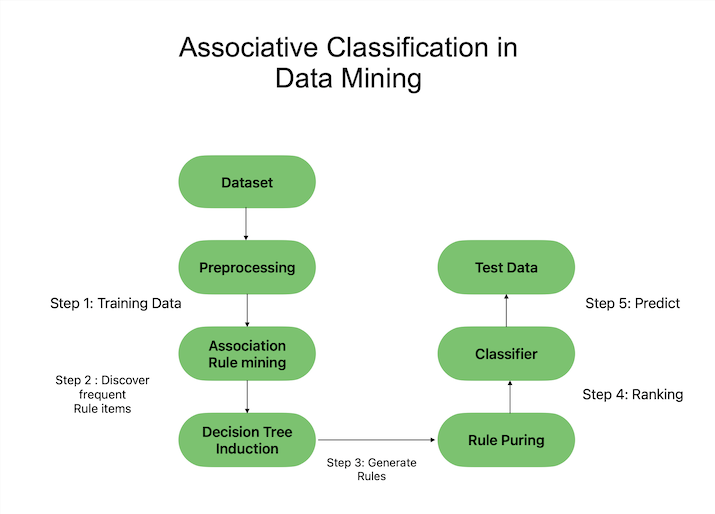
 Data Structure
Data Structure Networking
Networking RDBMS
RDBMS Operating System
Operating System Java
Java MS Excel
MS Excel iOS
iOS HTML
HTML CSS
CSS Android
Android Python
Python C Programming
C Programming C++
C++ C#
C# MongoDB
MongoDB MySQL
MySQL Javascript
Javascript PHP
PHP
- Selected Reading
- UPSC IAS Exams Notes
- Developer's Best Practices
- Questions and Answers
- Effective Resume Writing
- HR Interview Questions
- Computer Glossary
- Who is Who
Associative Classification in Data Mining
Data mining is an effective process that includes drawing insightful conclusions and patterns from vast amounts of data. Its importance rests in the capacity to unearth buried information, spot trends, and make wise judgments based on the information recovered.
A crucial data mining approach called associative classification focuses on identifying connections and interactions between various variables in a dataset. Its goal is to find relationships and patterns among qualities so that future events can be predicted or new occurrences can be categorized. Associative categorization can be used to uncover useful patterns that help businesses and organizations better understand their data, make data?driven choices, and improve their operations.
This method offers a thorough framework to identify intricate linkages in data, resulting in insightful information and prospective advancements in a range of industries, including marketing, finance, healthcare, and more. We'll be talking about associative classification in data mining in this post. Let's begin.
Understanding Associaltive Classification
Understanding associative classification is essential for realizing its full potential in data mining. Making prediction or classification jobs easier, entails identifying correlations and links between attributes in a collection. The fundamental goal of associative classification is to identify patterns connecting different variables by using association rule mining techniques.
Rule creation, rule assessment, and rule selection are generally the three main steps in the process. When rules are developed, they are based on the dataset, however, when rules are evaluated, they are evaluated for quality and importance. In order to improve the accuracy and relevance of the classification process, rule selection seeks to weed out unimportant or inapplicable rules. A few benefits of associative categorization are its capacity to manage complicated data linkages, manage high?dimensional datasets, and give comprehensible rules.
The computational complexity of big datasets, sensitivity to noise and irrelevant features, and a possible trade?off between accuracy and interpretability are some of its drawbacks. Nevertheless, being aware of these factors enables data analysts to employ associative categorization efficiently and base choices on the discovered patterns.

Techniques and Algorithms
Apriori Algorithm and Its Role in Associative Classification
In associative classification, the Apriori algorithm is a key method that is essential for identifying popular item sets. The method finds itemsets that meet a minimal support criterion via an iterative technique, creating strong correlations between qualities. Its main function in associative categorization is to produce a set of frequent item sets from which association rules may be derived.
Utilizing the "apriori property," which stipulates that any non?frequent itemset must have non?frequent subsets, the method effectively prunes the search space.
Fuzzy Association Rule Mining and Its Applications
A development of conventional association rule mining that addresses ambiguity and imprecision in data is fuzzy association rule mining. In datasets where characteristics include degrees of membership rather than binary values, it enables the discovery of relationships.
In fields like medical diagnosis or consumer behavior research, where ambiguity and vagueness are common, fuzzy association rule mining is very helpful. This method uses fuzzy logic to generate rules and identify correlations, allowing for more informed decision?making and the identification of patterns in large datasets.
Evaluation and Validation
Metrics of association rules
To assess the value and importance of association rules produced by associative classification, many metrics are used. The metrics lift, support, and interestingness are frequently employed. The potency of connections, the accuracy of forecasts, and the applicability of the patterns found are all quantified by these measures.
Cross?Validation and Holdout Methods for Model Evaluation
Cross?validation and holdout approaches are frequently used to confirm the efficacy of the associative classification model. By splitting the dataset into several subsets, cross?validation enables repeated training and testing on various partitions.
Holdout approaches, in contrast, divide the data into training and testing sets, utilizing the first to build the model and the latter to assess how well it performs.
Techniques for Handling Imbalanced Datasets
Associative categorization can be complicated by datasets that are unbalanced in terms of class distribution. Undersampling, oversampling, and ensemble procedures, among others, can be used to balance the dataset and lessen the effect of class imbalance on model performance.
Conclusion
In the area of knowledge discovery, associative categorization is crucial because it makes it possible to draw important conclusions and patterns from large, complicated datasets. In order to gain a deeper grasp of underlying patterns and dependencies, it reveals hidden knowledge by discovering correlations and interactions between characteristics. Applications in a variety of fields illustrate its adaptability and usefulness. It is essential to market basket analysis in the field of marketing since it enables companies to comprehend consumer purchase patterns, suggests pertinent items, and enhance sales tactics.

